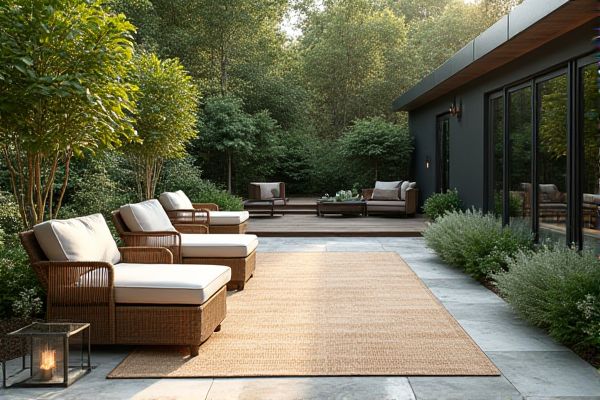
Outdoor rugs offer a soft, colorful layer that enhances comfort and style, while deck tiles provide durable, weather-resistant flooring with easy installation and a modern look. Explore the rest of this article to find which option best suits your outdoor space and your personal preferences.
Table of Comparison
| Feature | Outdoor Rug | Deck Tiles |
|---|---|---|
| Material | Polypropylene, polyester, natural fibers | Wood, composite, PVC, rubber |
| Installation | Easy, no tools needed, laid over surface | Requires interlocking or adhesive, moderate effort |
| Durability | Moderate; fades with UV exposure, prone to wear | High; weather-resistant, designed for outdoor use |
| Maintenance | Simple cleaning with broom or hose | Periodic cleaning, may require resealing (wood) |
| Comfort | Soft underfoot, absorbs noise | Firm surface, less cushioning |
| Drainage | Usually water-resistant but can trap moisture underneath | Excellent drainage through gaps between tiles |
| Appearance | Variety of colors and patterns | Natural wood or contemporary styles |
| Price | Lower cost, budget-friendly | Higher cost, investment for longer life |
| Portability | Lightweight, easy to move or replace | Heavier, less portable once installed |
Introduction to Outdoor Rug vs Deck Tiles
Outdoor rugs and deck tiles both enhance exterior living spaces with distinct benefits tailored to different needs. Outdoor rugs provide a soft, stylish surface that adds color and comfort to patios and decks, made from weather-resistant materials like polypropylene. In contrast, deck tiles offer a durable, modular flooring solution that is easy to install and maintain, often made from composite wood, plastic, or stone for long-lasting outdoor use.
Material Comparison: Outdoor Rugs and Deck Tiles
Outdoor rugs are typically made from weather-resistant materials like polypropylene or polyester, offering durability against moisture and UV rays while providing a soft, flexible surface for your deck. Deck tiles often use materials such as wood, composite, or stone, ensuring sturdiness and a solid foundation that can withstand heavy foot traffic and outdoor conditions. Choosing between these options depends on your preference for texture, maintenance needs, and the specific environmental exposure of your outdoor space.
Durability and Weather Resistance
Outdoor rugs made from polypropylene or olefin fibers offer excellent resistance to moisture, mildew, and UV rays, making them durable for various weather conditions. Deck tiles, often crafted from hardwood, composite materials, or porcelain, provide superior structural strength and can withstand heavy foot traffic and extreme weather without warping or cracking. Both options enhance outdoor spaces, but deck tiles generally offer longer-lasting durability under harsh environmental stress compared to most outdoor rugs.
Installation Process: Which Is Easier?
Outdoor rugs offer a simple installation process, requiring only unrolling and securing with rug pads or weights to prevent slipping, making them ideal for quick and hassle-free setup. Deck tiles typically involve snapping or interlocking pieces together, which can be straightforward but might require precise alignment and occasional trimming for irregular spaces. Overall, outdoor rugs provide an easier installation experience compared to the more involved process of fitting and arranging deck tiles.
Maintenance and Cleaning Requirements
Outdoor rugs require regular vacuuming and occasional washing to prevent mold, mildew, and dirt buildup, while deck tiles typically need periodic sweeping and hosing down to remove debris and prevent stains. Outdoor rugs made of synthetic fibers tend to dry quickly and resist fading, reducing overall maintenance time. Your choice depends on whether you prefer low-maintenance cleaning with deck tiles or the softer comfort of outdoor rugs that need more frequent care.
Comfort and Safety Underfoot
Outdoor rugs provide a soft, cushioned surface that enhances comfort and reduces fatigue when walking or standing for long periods. Deck tiles offer a firmer feel but often include non-slip textures and drainage features that improve safety by preventing slips and water accumulation. Both options contribute to outdoor comfort and safety; however, rugs excel in softness while deck tiles prioritize stability and grip.
Design Versatility and Aesthetic Appeal
Outdoor rugs offer design versatility with a wide range of colors, patterns, and textures that can easily complement any decor style, enhancing your space's aesthetic appeal. Deck tiles provide a modular approach allowing customizable layouts and natural materials like wood or stone, adding a sophisticated and durable look to outdoor areas. Both options enhance outdoor environments, but your choice depends on whether you prefer the softness and variety of rugs or the structured, elegant design of tiles.
Cost Comparison: Initial and Long-Term Investment
Outdoor rugs typically have a lower initial cost, ranging from $50 to $300 depending on size and material, while deck tiles usually start around $100 and can exceed $500 for higher-end options. Long-term investment for outdoor rugs includes periodic replacement due to wear and weather exposure, often every 2-3 years, whereas deck tiles generally offer greater durability with a lifespan of 5-10 years or more, reducing replacement frequency. Maintenance costs also differ, with rugs requiring cleaning and occasional replacement, while deck tiles may need minimal upkeep such as sealing or cleaning to preserve appearance.
Best Uses and Practical Applications
Outdoor rugs provide comfort and style for patios, decks, and porches, ideal for defining seating areas and adding warmth underfoot. Deck tiles offer a durable, modular solution perfect for creating level surfaces on uneven decks, balconies, or rooftop terraces. Both options enhance outdoor living spaces, with rugs focusing on aesthetics and softness and tiles emphasizing structural integrity and easy installation.
Pros and Cons: Outdoor Rugs vs Deck Tiles
Outdoor rugs offer easy installation, affordability, and a wide range of styles, but they can fade in direct sunlight and may retain moisture, leading to mold growth. Deck tiles provide durability, better drainage, and a more polished look, yet they require more effort to install and can be costlier than rugs. Choosing between the two depends on factors like maintenance preferences, budget, and desired aesthetic for outdoor spaces.
 homyna.com
homyna.com